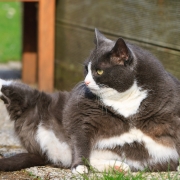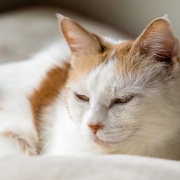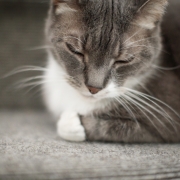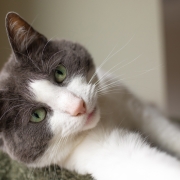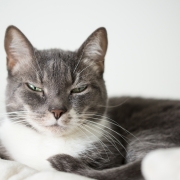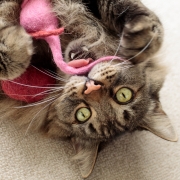Obesity is one of the leading health challenges in domestic cats, and it significantly increases the risk and severity of osteoarthritis (OA).
Extra weight places more stress on joints, fuels inflammation, and worsens chronic pain—often resulting in decreased activity, further weight gain, and reduced quality of life. Beyond OA, overweight cats face greater risks of diabetes, lower urinary tract disease, and other costly comorbidities.
As veterinary teams, we play a key role in helping clients understand the connection between body condition, pain, and behavior—and in offering realistic strategies that fit into their daily routines.
Why Feeding Habits Matter
- Prevalence: Over half of cats in the U.S. are overweight (Association for Pet Obesity Prevention).
- Natural behavior: Feral cats spend ~12 hours a day hunting, compared to 3 hours or less for domestic cats.
- Impact: Traditional “bowl feeding” may meet nutritional needs but removes opportunities for stalking and problem-solving. This lack of stimulation can contribute to overeating, boredom, stress, and behavioral issues (scratching, chewing, aggression).
Clinical insight: Position enrichment feeding not just as weight management, but as a multimodal welfare tool that addresses physical, emotional, and behavioral health.
The Concept: Frequent Feasts of Tiny Eats
Encourage clients to divide daily rations into 4–6 small meals rather than one or two large feedings. This mimics a cat’s natural hunting rhythm and reduces the tendency to overeat. Free-choice feeding allows nibbling but does not address the behavioral enrichment cats need.
Enrichment Feeding Strategies You Can Recommend
Commercial Puzzle Feeders
- Wide variety available—balls, mazes, cups, and dispensers.
- Help slow down eating while engaging cats physically and mentally.
- Tip: Keep a small selection in-clinic to demonstrate and recommend specific products.
DIY Puzzle Toys
- Hollow toys with wet food (freeze for added difficulty).
- Toilet paper rolls in boxes with kibble dropped in.
- Ice cube trays or egg cartons with food hidden under scrunched paper or toys.
- Treasure hunts—encourage owners to hide small portions of food throughout the house.
Add More Challenge
- Place puzzles inside paper bags or boxes to require additional effort.
- Vary hiding spots and puzzles to maintain novelty.
How to Communicate With Clients
- Start simple: Recommend one or two easy enrichment methods to avoid overwhelming owners.
- Reframe the benefit: Position this as a way to keep cats healthier and happier while reducing boredom-driven behaviors.
- Pair with weight management: Use enrichment feeding as part of a structured plan that also includes diet adjustments and OA pain management when appropriate.
Key Takeaway for Veterinary Teams
Frequent, enrichment-based feeding strategies can break the obesity–arthritis cycle, reduce stress behaviors, and improve feline welfare. By guiding clients toward small, practical changes—like puzzle feeders or creative DIY options—we not only support healthier body condition but also enrich the human–cat bond.
Monique Koll, DVM, CCRP, CVPP
Certified Cat Friendly Veterinarian by the Feline Veterinary Medical Association
#frequentfeastsoftinyeats
References
- Purrfectly Entertained: Indoor Enrichment for Cats – AAHA
- Creative Cat Enrichment Ideas | Purina US
- CAT-ching Up On Feline Enrichment | VMBS News
- Indoor Pet Initiative
- https://icatcare.org/
- https://icatcare.org/articles/playing-with-your-cat
- Herron ME, Buffington CA. Environmental enrichment for indoor cats. Compend Contin Educ Vet. 2010 Dec;32(12):E4. PMID: 21882164; PMCID: PMC3922041.

